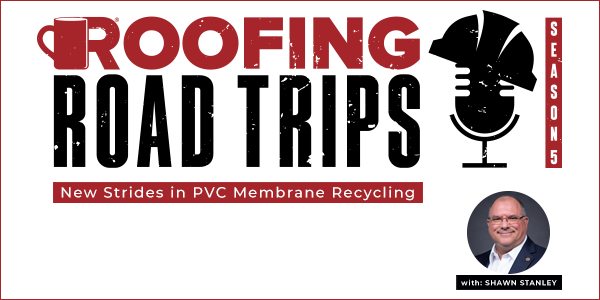Roofing Road Trip with Heidi - Special Guest Jason Stanley - Savage Estimating Podcast

Editor's note: The following is the transcript of an interview with Jason Stanley, CEO of IB Roof Systems. You can read the interview below or listen to the podcast here.
Heidi Ellsworth: Hello and welcome to Roofing Road Trips with Heidi Podcast for Roofers Coffee Shop. This is Heidi Ellsworth, a partner at the Coffee Shop. Today, I am so honored to be sitting here and visiting with Jason Stanley, CEO of IB Roof Systems. I have had just such an amazing time getting to know Jason. We're both Oregonians, but Jason, you and your family moved away a little bit. But we kind of have a lot of the same background. I'm excited to share your history and some of your really thought leadership with our audience today. Welcome.
Jason Stanley: Well, thank you, Heidi. I'm pleased to be here as well and our roots are still deep in Oregon. We still cheer for the Oregon Ducks in basketball and football. For those that know, Oregon will be playing in the Rose Bowl again this year against Wisconsin. So I'll be out there cheering on the Ducks January 1st in Pasadena.
Heidi Ellsworth: Oh, wow. Aren't you lucky? That is great. That will be so much fun. I have so many Duck fans who are friends of ours and who will be heading that way. So you'll probably see a lot of people coming down from the North to go see that. But why don't you tell us and tell our audience just a little bit about your history? I mean, IB Roof Systems, a family owned business, some of those great pictures that we share on the Roofers Coffee Shop of you and your brothers and family. I'd love for you just to share with the audience a little bit of that history and more about yourself.
Jason Stanley: Absolutely. The company was founded back in 1978 by my father, Larry Stanley. He had a master's in engineering and moved to Oregon. They had five boys and was teaching school and in the summertime had a roofing company. At the time, he was mostly doing coatings, actually a quite well known product called Rapid Roof by Conklin. In 1978, he discovered PVC Single-Ply from Europe and started importing the product and really felt like PVC was going to revolutionize the roofing industry. With a lot of struggles, he eventually grew into a very successful company selling PVC based on the merit of providing a roofing centric product. What I mean by that is a product that is easier for roofing contractors to put down than others. And that's kind of become this fundamental drive for IB Roof Systems, is to put together products that are easier for contractors to install. Products that perform and are designed to perform longterm and be easy for the contractors to handle and manage. So we spent a lot of emphasis on training both on the sales side and the installation side. We've built a base of 400 plus contractors that buy products here every week that we enjoy long longterm relationships with.
Heidi Ellsworth: That is great. So you grew up in a roofing family as I did. My dad was a general contractor and did remodels, homes, roofing, the whole nine yards. But there's something to be said for growing up in that family and then really being such an important part of the industry like you are. Can you shoot us a little bit of your personal background and now your current role at IB?
Jason Stanley: For sure. I've been on roofing since I was about 13 years old. And in doing so, I grew up from a gofer on a roof that would go and pick up just about anything and everything for somebody else, and then grew into welding and detailing and then became a project manager and ran jobs, and then grew into estimating. When I was 22 years old, I moved up to Seattle and started my own roofing company as well. I did that long enough to understand that roofing is extremely difficult and hard business to be in. But in a very short period of time, I became my father's biggest customer in Seattle, Washington. Later was named the rep and sold the business and that started my sales journey. So I've managed the State of Washington for about five years and then moved to Colorado and started putting in reps across the Western United States. I did that for almost 20 years. Then became the national sales manager for the company and then eventually the CEO.
Heidi Ellsworth: Wow.
Jason Stanley: So I've worn just about every hat in this business.
Heidi Ellsworth: That's what I was just going to say. That is so impressive because you really have seen all sides of the industry. So when you're sitting and working with the great IB Roof System contractors, you've been in their shoes. You know what it's all about.
Jason Stanley: Yeah. There's one thing about learning from your own personal experiences. You're just one person and you may estimate two or three or four or five jobs in a day and the experience you get is just your own personal experience. What we have the benefit of doing in my position being either a local sales rep, be it in Seattle or Denver, Colorado, or running the Western United States and then for years being the national sales manager, is I got access to hundreds of contractors and hundreds if not thousands and thousands of projects. Where I learn and grow from everybody, be it the owner of the company that wants to share his challenges, his experiences, his successes, as well as estimator and installers. I get a gleam from everybody's best practices and in some cases, mistakes that we get to learn from.
Heidi Ellsworth: I think that makes such a huge difference. I've been lucky enough to work for a roofing contractor, to work for manufacturer, to work in technology. So I really... You see so much. I think it's important as you start trying to do what you've done as CEO. I know that there's a lot of misconceptions and what you and I have talked about largely perceived truths that roofing contractors can simply add a multiplier and percentage to materials to cover the overhead. I would love for you to talk about that. That is something that I think is so important to the contractors on being profitable. So share a little bit of your thoughts on that, Jason.
Jason Stanley: Absolutely. So the roofing industry has one of the highest attrition rates of any trade that's out there. It is a difficult, difficult company to run and manage. There are many variables from material supply, to available labor, and then of course the all mighty weather that controls what we can get done in a given year. So there are a lot of challenges that come with roofing. But what I'm finding is one of them biggest challenges that exist today is people don't know how to properly estimate. I don't mean that in some sort of high-d or high that, "I know this information that you don't or I am somehow more knowledgeable than you are." I was just taught to estimate a certain way. I talk to these contractors today. I would suggest nine out of 10 contractors today use a multiplier of materials or a multiplier of materials and labor and a percentage to estimate projects. It steers you in entirely wrong direction.
Heidi Ellsworth: How is that? Talk about that direction. Because I know you've been helping a lot of contractors and this is one of your top initiatives. So really how they can estimate and know how much they're making per day. Keep going with that.
Jason Stanley: Well, let's take a contractor that says, "My benchmark is 35%. That's what I need to make." Well, 35% of what? So I'll hear from contractors that, "Yeah, the roofing project came in on target. I made my 35%." Well, again, if you're taking a material times a multiplier, 35%, and you have a relatively low cost roof assembly, let's say it's just a cover board or a separation barrier or a roof membrane and it's relatively inexpensive. If you're using a low cost basis for the materials and you multiply it and you put a percentage on, the profit for that job is extremely low. The percentage may be on target, but the overall profit is low. What you also see to the contrary is a job that may have two layers of 2.6 polyiso and a cover board and fully adhered membrane, and they want to use a 60 mil or an 80 mil membrane and all these cost drivers and use the same multiplier and the same percentage. I talk to contractors oftentimes. So they're pulling the face and they're like, "I'm making the same thing. I'm making the same percentage on that job that I was on this other job." But it's a percentage of what? Percentage of a dollar is a very small amount. Percentage of $10 is 10 times more. So contractors don't seem to draw a connection between the actual dollars left. Most contractors if you ask them, if they job cost. They will tell you, "Yes. I go back and I look to see if I got my percentage that I was supposed to make." A fewer number of contractors take that percentage and actually calculate it to dollars. That's a good step in the right direction. But almost nobody today takes a project unless if the total dollars and then divides it across the numbers of days that it took to earn the money. That's profitability by day and that's powerful. That changes the projects you're going to pursue, the profitability you're making. There are only so many roofing days in a year, and the jobs you choose to fill those roofing days determine your profitability at the end of the year. So we want to be filling those roofing days with the most profitable jobs possible. As we've seen or I just illustrated, the profitability when you're using 35% changes drastically based on the number or the multiplier you're putting in place. So if you can get to profitability by day, you can find a constant and you'll start looking at projects going, "I'm only making $500 a day on that project and I'm making $5,000 a day on this other project."
Heidi Ellsworth: I think that when we talked about that, it just makes so much sense. It's also, where are you putting your valuable time and treasures and talent? Right? You want to put it where it's the most profitable. I love what you call this, Savage Estimating. I understand that this initiative or this idea of being a savage estimator started with your dad, which I think is really cool. As you said, this is how you learned. Can you share a little bit? Tell us about savage estimating and how it works.
Jason Stanley: Yeah. The reason why I call it savage estimating is because if you follow this prescribed method of having four fundamentals of estimating: materials, labor, overhead, and profit, you will become a savage estimator. Why I say that so boldly is when you show up to a job site and you have six contractors bidding a job and they're all bidding it for $60,000 and you're a savage estimator, you've done the math, you've looked at profitability by day, and you may be at $90,000 for that job. You can be okay standing there going, "No. I need to be at $90,000 for this job," even when the rest of the industry is all bidding at 60,000 because they don't know how to estimate. Likewise, you walk into a project that's $1.2 million and you're $200,000 under everybody else. You can hold your head high and everybody else is saying, "Look at that fool. He's going to lose money on that job." You shake your head and say "No. I know how to properly estimate and I'm making more on this job than you realize." Because you're not going off these percentages that are truly all over the place that don't really drive profitability by day.
Heidi Ellsworth: That makes sense. So one of the things you say that I just really love is learning by guessing takes a long time, learning by focusing on what is important equals success. I just think that's so good. Talk a little bit more about that. Expand on that concept too because it kind of goes to everything that you're talking about right now.
Jason Stanley: Yeah. So a lot of this goes back to job costing. Becoming a savage estimator really forces you to look at, "Did my materials come in? What is my material cost?" People want to say all the time, "What's your cost per square foot on your membrane?" I can promise you it doesn't matter if it's 42 cents a square foot or 95 cents a square foot. You have to look at the entire materials for the job. One manufacturer may require this complex roof assembly while another manufacturer that has a more expensive membrane may have a lower cost assembly that drives the overall material cost down. So you have to look at the details of, "What is my material cost?" Then you have to look and focused on your labor, how long is this job going to take? How many days is it going to tie up? How many roofing days, if you will? Then calculating your overhead and your profit. If you'll come back through and you'll do job cost, and you'll quickly understand, "I had this job set up for seven days. How come it took nine?" And you can interview the crew and find out, "Oh yeah, it was seven foot walls. Oh, well, seven foot walls take a lot longer to hang than maybe a three foot or two foot wall." And you start to understand what the cost drivers are. You show up on a project, "How come this one took longer?" "Oh, you see this equipment? Well, we spent two days roofing 10 squares." "Oh, okay. I'll keep that in mind." "This roof assembly, we typically get 30 to 50 squares down a day, but when there was an equipment like this, I need to allow for extra time." You also start learning the things you missed. When you put together your material list and that comes in and you job cost based on your materials, you start finding, "Oh, wow, they need a cover strip. I haven't been accounting for that." And the guy at the office, he orders it or the crews in the field, they order it and they need it. But when you start evaluating all those things, you start to find the things that you're missing or the things that are real drivers from a labor standpoint or time standpoint on an overall project.
Heidi Ellsworth: So as you've been working with some of your contractors and helping them with this and the savage estimating, what are some of the things you're hearing back from your contractors?
Jason Stanley: Heidi, one of the biggest things is actually trying to get contractors to understand that there's even a problem. The biggest problems that exist in our industry is probably this one and the biggest issue is that no one really recognizes it. People don't understand profitability by day. So I have worked ad nauseam over the last year trying to find a metaphor or a story that would resonate with people. I think I finally have one that truly hits home that makes people or helps people understand what I'm talking about. So if I offered you to come work for me for $10,000, what should be the first question you should ask?
Heidi Ellsworth: How long do I have to work for that $10,000?
Jason Stanley: Yeah. Because if it's $10,000 a day, well, that's $3.6 million a year. Where can I sign up?
Heidi Ellsworth: Yeah.
Jason Stanley: If it's $10,000 a year, I'm pretty sure you have better things to do with your time. If it's $10,000 a month, well, maybe we can have a conversation because that's $120,000 a year. So the reason I share that story is because $10,000 is only important when it's relative to time. So let's translate that into roofing. I show up at a roofing contractor's office. They're excited to show me a project they just finished with IB PVC, and I said, "How much did you make on it?" "Well, we came in on target. We're at our 35 or 40," Or whatever their percentage is that they use. I said, "No. How much did you make?" They'll say, "I made $70,000." They're excited. Then I ask a question of, "Well, how long did it take?" They don't understand the question. I'm saying, "Well, how long did it take to earn $70,000?" It's great that you made $70,000 on the job. If you did it in a day, well, maybe I'll come work for you because that's amazing. If it took you 10 days, that's $7,000 a day. If it took you six months, you're probably going to go out of business. So just because you made $70,000 on a day or $70,000 on a project, excuse me, it only makes sense when it's relative to time. The way you get that, you take your project, your profitability in dollars, and you divide by the number of days. When you start doing that on projects, you will quickly see some jobs you're making your same 35% on, you're only making $500 a day and other jobs that you're making the same 35%, you're making $5,000 a day. So stop picking the losers and start picking the winners and you'll fill up your roofing year with projects that are profitable. That you're making more and more money. You can control your own destiny at that point.
Heidi Ellsworth: I think that makes so much sense. I think, Jason, is you're looking at this and you have your team, and like you said, you've been really working on this not just in the last year but for a long time, how are you helping IB Roofing contractors? How are you helping them kind of get past that and maybe on your sales team and also your... I know you have an awesome customer service team. What are some of the things that you're doing for contractors right now to help them with the savage estimating?
Jason Stanley: Well, a large part of it starts with just identifying the membrane cost. The first conversation everybody wants to have is, what's the cost per square foot of your membrane? And we help contractors by helping them understand that it doesn't matter if it's 43 cents or 44 cents. That's a game that manufacturers play all day long. You need to look at the total material cost. So the best thing we can do for contractors is get them to ignore the cost per square foot and start focusing on, "What is your total material cost? What is your labor? And then how long is it going to take to put this project together and how quickly can we get it done?" Contractors start to quickly see that when you look at the total material cost, manufacturers are charging them $30 for a simple pipe flashing. They're charging them three times the square foot rate when they're talking about cover strips. They're gouging them on glues and fasteners and other things. When you put the whole material list together, we find that a product that costs 80 cents a square foot versus a product that costs 45 cents a square foot oftentimes has an almost identical total material cost to the job.
Heidi Ellsworth: That's amazing. That can make all the difference. I mean, I love that thought too of really... Because you know what? I've been involved with manufacturers and you look at some of the accessories and you're right. They're kind of making up for maybe dropping the membrane prices. But what you're talking about is really having honest pricing and looking at the whole system, which you would think everyone is doing that, but you're right. That's not how the conversation starts.
Jason Stanley: Yes. So a contractor would call here and say, "Can I get two more cents per square foot? Because that's where I need to be on this job." I can assure you two cents per square foot isn't going to make a [inaudible 00:20:41] on that job. What I can assure you is that if we have conversations about what is the roof assembly and what is the right roof assembly, we may be able to shave 20 cents or a dollar a square foot out of a project by designing a system or truly perform and work or maybe a better roof assembly overall rather than just focusing on the cost per square foot of the membrane. I think another thing that contractors don't realize is that manufacturers are basically leveraging them. They're giving them a lower material cost sometimes. Roofing contractors are then taking that and putting their multiplier on it and the percentage on it. So just because a product costs $10,000 more, well, that's just the one cost. That's just membrane or that's just materials that's $10,000 more. When you take that additional $10,000 and use it as a basis for a multiplier in a percentage, suddenly, you're bidding a TPO system versus a PVC system. To the building owner, the cost difference is $50,000 and they can't justify it, so they go ahead and go with the lower cross TPO. The reality was the difference in cost was maybe a push or maybe $5,000 or $10,000. It wasn't this crazy upcharge. It's just the way the contractors are estimating. So when you can try and start to break out materials as a single element or fundamental of estimating, and then focus on labor as a separate fundamental and then looking at overhead, purely just overhead, and then profit, only then do you start to see where they all come together and you can start estimating for profit and become a savage estimator.
Heidi Ellsworth: That's right. You really are making me think because when you look at... You're talking about even on labor, if you're using certain systems, I know we've talked about smaller rolls, can go on faster. It's easier on crews. Maybe you don't even need as many crew members. That all of a sudden changes that estimating too. So there's so many factors that I know you're working on quality of membrane, but you're also working on a lot of features that help make labor go faster too, right?
Jason Stanley: Yeah. I would suggest it's... We sell roofing centric products. When I say that, they're products that you don't need a seam sealing on. The rolls are sizes that two men can pick them up and move them around a job site. A product that has a wide welding window where you can turn your gun all the way up, or you can turn it down. You can weld into a corner. You can weld when it's 105 degrees or 40 degrees and still get a good weld. There's all these things that we put together in a product that try and meet the customer where they're at on a job site to get a successful job done rather than the industry today that is just bombarded with pricing and, "How can I take a good product and continue to value engineer it until it doesn't perform anymore?" I think we've all seen that.
Heidi Ellsworth: Yeah. I love that contractor centric. That is what I hear from you and your team all the time, really understanding what the contractors need to be successful. I know that's really a pillar or a mission of IB Roof System. So maybe just before we go and I have one other question after this, but talk just a little bit about that contractor centric and also contractor centric manufacturing. What you've been doing with research and development and how you really are focused in on that.
Jason Stanley: Well, we can maybe get into this in a little more detail in another future podcast, but one of my big issues is these wide width rolls that we're trying to push down contractors throats. We spent hundreds of thousands of dollars and when I say we, the industry is trying to promote the wide rolls are going to save some sort of time and energy on a roof and it's simply not true. Today, what we're seeing is when you do the math on a 200 square project that the labor savings is one man hour, one man hour. So if you have a crew out there, four or five guys, you're not getting home any sooner or completing that job any faster. In fact, you're using 25% more fasteners and saving one total hour of labor on 200 square project. It's true there's 700 more feet of lineal seam to weld up. That's a reality, yes. But you have to use more fasteners with a wider width sheet. Fasteners take time to put down as well. But 700 lineal feet of seaming, it takes about 45 minutes for a skilled guy to weld with a robotic welder. So it's not crazy. Well, what you do get is you get rolls that only weigh 200 pounds. The guys can move around on the roof, position, build a back roll, lift over a pipe, lift over a curb, and seams that weld together don't come apart. We don't have those sort of issues. So in taking a sheet like ours and putting it in a roll that's more, I guess, roofing centric for the contractor to handle on a job site, we can reduce the number of back injuries which according to CNA, is the number one most debilitating, most expensive injury claim in the roofing industry today. But yet, manufacturers want to continue to make rolls that weigh 500 pounds and have contractors move them around on job sites. It's just not practical. That goes from our rolls down to our accessories. Be it drains or be it pipe flashings or details and how we do them to try and make it truly easier on the job site. We prefab as much as we can that makes sense to give it to the roofing contractor so it doesn't take your most skilled laborer to put it down. Then you can get a complete successful job in a shorter period of time.
Heidi Ellsworth: And you know by looking at that, by putting those two things together, first of all, figuring out what provides the highest performance, the best labor on savings on the roof combined now with understanding, like you said, the drivers and the estimating and how to put all that together, that really means success for the contractors. Jason, I love this. Thank you. I know... I do want to point out. Like I said, I have one more question we're going to go into. But I want to point out to our audience that we have a lot of articles, some great infographics, information on Roofer's Coffee Shop in the IB Roof Systems' directory and throughout the site. Where they have been just really providing this kind of information that can help contractors plus the ibroofsystems.com, their site, is amazing with all kinds of resources. So for all of you listening, be sure to check all of this out. But before I let you go, Jason, I know you're headquartered in Dallas, Texas. We have a big event coming up in a month with the IRE. Can you tell us a little bit of what you guys are working on and what you're going to be doing during that show, maybe promoting at your booth?
Jason Stanley: Yeah. Well, our focus will always be talking with contractors about how we can make their business better because that's what makes us better as a company, is making the roofing contractors that buy our products truly better. There's a lot of reps that go out and say, "Give me six months. Buy our product for six months, and if your company isn't better because of it, then you can go back to buying whatever else you were buying before." But that's the reality. That's what we want to do and that's what we want to project to roofing contractors, is that we're not just a roofing membrane supplier. We're a partner. We want to get into your business and find out what makes it tick, how you can improve and how we can make you better. Because that means you're going to be around for a longer period of time and you're going to buy even more material. But what may be most exciting about this upcoming IRE is kind of going back to our roots of the 70s. I cut my teeth at the age of 13 years old on a roof spreading coatings. We're going to be introducing an entire coating line that will be one of the best coating in the roofing industry today. With the advent of a lot of roofs, the single-ply roofs, predominantly TPO that are failing in the marketplace, there is a huge overwhelming number of roofs that need to be coated. We now are going to be supplying the coating that can coat those projects as well as others in the industry. It will be exciting to add a roofing centric coating line in addition to our PVC membrane that we've been selling for over 40 years.
Heidi Ellsworth: That is super exciting. Congratulations. That is going to be amazing for your contractors and for all the contractors who are discovering what a great company and what great products that you have. So I'm looking forward to seeing it in Dallas. I'll be there. I know we'll be having a great show. I'm really thankful to have you on this podcast today to kind of give a little sneak peak and also really share what you're doing for the contractors, Jason. Thank you so much.
Jason Stanley: Well, Heidi, I'm a huge fan of the Roofers Coffee Shop. I love everything you're doing for this industry as well. So kudos to you and all the hard work and effort you put to try and make this a better place.
Heidi Ellsworth: That's great. Thank you. Thank you so much, and thank you everybody for listening. We will be putting out our podcast weekly. So be sure to check for all the podcasts under the Read, Listen, Watch, RLW section of Roofers Coffee Shop. Have a great rest of your week and we'll see you in Dallas.






















Comments
Leave a Reply
Have an account? Login to leave a comment!
Sign In